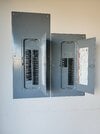Hello,
New MSP owner with delivery next week. I have my breaker box in my garage but no current 240v outlets there. Contemplating having a 240v installed to a 50amp breaker but wanted to run a couple questions by the group.
1) I've had 2 electricians tell me since it would be an outdoor receptacle, they'd recommend (and might be code) to get GFCI. Had two other electricians say not worth the trouble and they wouldn't even pull permits for it. I've also read forum posts here saying GFCI shouldn't be necessary (and may even be problematic). Wanted to check again what everyone's thoughts are for an outdoor 240v receptacle and GFCI breaker.
2) I am likely parking my Tesla outdoor daily, and thus the outdoor 240v. However on the off chance that I park in the garage in the future, I was contemplating having a second 240v receptacle installed on inside of the exterior wall. This would allow one 240v inside the garage on the drywall, and a second on the brick outside. Obviously they both can't charge simultaneously being connected to the same 50amp breaker, which is irrelevant as we only have one electric car. But this might "future proof" any issues that arise if I wish to park and charge in the garage in the future.
Attaching a couple pictures. The red circle would be the ideal location of the outdoor receptacle.
Thanks in advance!
New MSP owner with delivery next week. I have my breaker box in my garage but no current 240v outlets there. Contemplating having a 240v installed to a 50amp breaker but wanted to run a couple questions by the group.
1) I've had 2 electricians tell me since it would be an outdoor receptacle, they'd recommend (and might be code) to get GFCI. Had two other electricians say not worth the trouble and they wouldn't even pull permits for it. I've also read forum posts here saying GFCI shouldn't be necessary (and may even be problematic). Wanted to check again what everyone's thoughts are for an outdoor 240v receptacle and GFCI breaker.
2) I am likely parking my Tesla outdoor daily, and thus the outdoor 240v. However on the off chance that I park in the garage in the future, I was contemplating having a second 240v receptacle installed on inside of the exterior wall. This would allow one 240v inside the garage on the drywall, and a second on the brick outside. Obviously they both can't charge simultaneously being connected to the same 50amp breaker, which is irrelevant as we only have one electric car. But this might "future proof" any issues that arise if I wish to park and charge in the garage in the future.
Attaching a couple pictures. The red circle would be the ideal location of the outdoor receptacle.
Thanks in advance!




